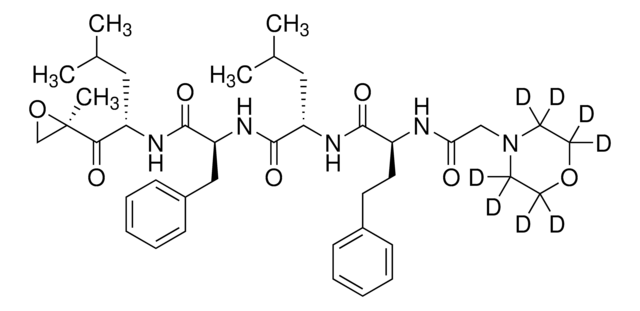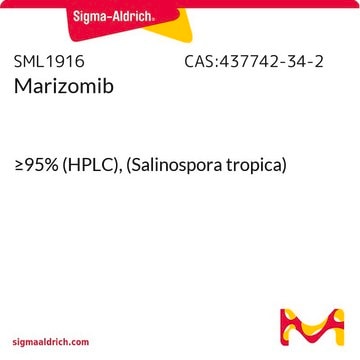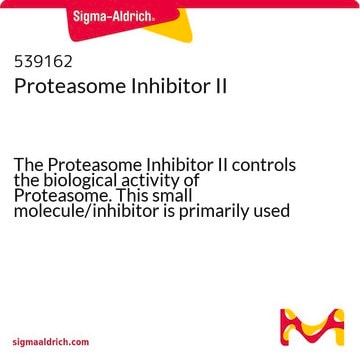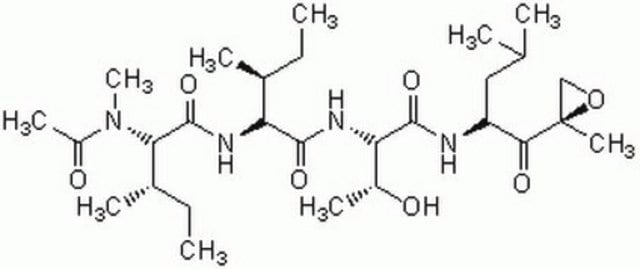5.04314
Bortezomib
≥98% (LC/MS), solid, 20S proteasome inhibitor, Calbiochem®
Sinonimo/i:
Bortezomib, (R)-3-Methyl-1-((S)-3-phenyl-2-(pyrazine-2-carboxamido)propanamido)butylboronic acid, BTZ, LDP-341, LDP341, MG341, MLN-341, MLN341, PS341, Proteasome Inhibitor XXII, PS-341, MG-341, Pyz-Phe-boroLeu, BTZ, LDP-341, LDP341, MG341, MLN-341, MLN341, PS341, Proteasome Inhibitor XXII, PS-341, MG-341, Pyz-Phe-boroLeu, (R)-3-Methyl-1-((S)-3-phenyl-2-(pyrazine-2-carboxamido)propanamido)butylboronic acid
About This Item
Prodotti consigliati
product name
Bortezomib,
Saggio
≥98% (LC/MS)
Livello qualitativo
Forma fisica
solid
Produttore/marchio commerciale
Calbiochem®
Condizioni di stoccaggio
OK to freeze
desiccated (hygroscopic)
protect from light
Colore
off-white
Solubilità
DMSO: 100 mg/mL
ethanol: 2 mg/mL (with sonication)
Temperatura di conservazione
−20°C
InChI
1S/C19H25BN4O4/c1-13(2)10-17(20(27)28)24-18(25)15(11-14-6-4-3-5-7-14)23-19(26)16-12-21-8-9-22-16/h3-9,12-13,15,17,27-28H,10-11H2,1-2H3,(H,23,26)(H,24,25)/t15-,17-/m0/s1
GXJABQQUPOEUTA-RDJZCZTQSA-N
Descrizione generale
Applicazioni
Azioni biochim/fisiol
Caratteristiche e vantaggi
- Cell permeable and enables targeted action
- Allows reversible modulation of cellular processes
Confezionamento
Attenzione
Nota sulla preparazione
Ricostituzione
Altre note
Tamatani, T., et al. 2013. Int. J. Oncol.42, 935.
Beck, P., et al. 2012. J. Biol. Chem.393, 1101.
Fang, H.T., et al. 2012. Proc. Natl. Acad. Sci. USA.109, 2521.
Chen, D., et al. 2011. Curr. Cancer Drug Targets11, 239.
Demo, S.D., et al. 2007. Cancer Res.67, 6383.
Adams, J., et al. 1999. Cancer Res.59, 2615.
Teicher, B.A., et al. 1999. Clin. Cancer Res.5, 2638.
Adams, J., et al. 1998. Bioorg. Med. Chem. Lett.8, 333.
Note legali
Codice della classe di stoccaggio
11 - Combustible Solids
Classe di pericolosità dell'acqua (WGK)
WGK 3
Punto d’infiammabilità (°F)
Not applicable
Punto d’infiammabilità (°C)
Not applicable
Certificati d'analisi (COA)
Cerca il Certificati d'analisi (COA) digitando il numero di lotto/batch corrispondente. I numeri di lotto o di batch sono stampati sull'etichetta dei prodotti dopo la parola ‘Lotto’ o ‘Batch’.
Possiedi già questo prodotto?
I documenti relativi ai prodotti acquistati recentemente sono disponibili nell’Archivio dei documenti.
I clienti hanno visto anche
Contenuto correlato
Select different protease inhibitor types based on your needs to prevent protein degradation during isolation and characterization and safeguard proteins in sample prep.
Il team dei nostri ricercatori vanta grande esperienza in tutte le aree della ricerca quali Life Science, scienza dei materiali, sintesi chimica, cromatografia, discipline analitiche, ecc..
Contatta l'Assistenza Tecnica.














